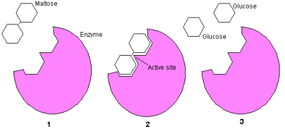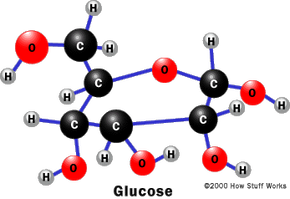Enzymes
At any given moment, all of the work being done inside any cell is being done by enzymes. If you understand enzymes, you understand cells. A bacterium like E. coli has about 1,000 different types of enzymes floating around in the cytoplasm at any given time.
Enzymes have extremely interesting properties that make them little chemical-reaction machines. The purpose of an enzyme in a cell is to allow the cell to carry out chemical reactions very quickly. These reactions allow the cell to build things or take things apart as needed. This is how a cell grows and reproduces. At the most basic level, a cell is really a little bag full of chemical reactions that are made possible by enzymes!
Advertisement
Enzymes are made from amino acids, and they are proteins. When an enzyme is formed, it is made by stringing together between 100 and 1,000 amino acids in a very specific and unique order. The chain of amino acids then folds into a unique shape. That shape allows the enzyme to carry out specific chemical reactions -- an enzyme acts as a very efficient catalyst for a specific chemical reaction. The enzyme speeds that reaction up tremendously.
For example, the sugar maltose is made from two glucose molecules bonded together. The enzyme maltase is shaped in such a way that it can break the bond and free the two glucose pieces. The only thing maltase can do is break maltose molecules, but it can do that very rapidly and efficiently. Other types of enzymes can put atoms and molecules together. Breaking molecules apart and putting molecules together is what enzymes do, and there is a specific enzyme for each chemical reaction needed to make the cell work properly.

You can see in the diagram above the basic action of an enzyme. A maltose molecule floats near and is captured at a specific site on the maltase enzyme. The active site on the enzyme breaks the bond, and then the two glucose molecules float away.
You may have heard of people who are lactose intolerant, or you may suffer from this problem yourself. The problem arises because the sugar in milk -- lactose -- does not get broken into its glucose components. Therefore, it cannot be digested. The intestinal cells of lactose-intolerant people do not produce lactase, the enzyme needed to break down lactose. This problem shows how the lack of just one enzyme in the human body can lead to problems. A person who is lactose intolerant can swallow a drop of lactase prior to drinking milk and the problem is solved. Many enzyme deficiencies are not nearly so easy to fix.
Inside a bacterium there are about 1,000 types of enzymes (lactase being one of them). All of the enzymes float freely in the cytoplasm waiting for the chemical they recognize to float by. There are hundreds or millions of copies of each different type of enzyme, depending on how important a reaction is to a cell and how often the reaction is needed. These enzymes do everything from breaking glucose down for energy to building cell walls, constructing new enzymes and allowing the cell to reproduce. Enzymes do all of the work inside cells.
